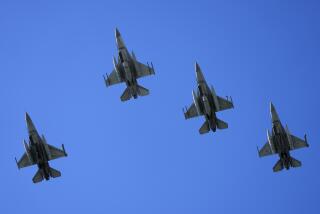Boeing Renews Push for Commercial C-17 Variant
- Share via
When Boeing Co.’s C-17 military cargo jet carried Keiko the killer whale to freedom two years ago, the flight grabbed headlines around the world. It was the only aircraft with enough heft and agility to ferry the 9,050-pound mammal and drop him off at a tiny airstrip near his native waters in Iceland.
But getting the airline industry interested in buying a commercial version of the plane has turned out to be a herculean task, one even tougher than the liberation of the star of “Free Willy.”
On Thursday, after failing for years to convince anyone in the industry to buy a commercial variant, Boeing will make its most crucial--and perhaps final--sales pitch before executives representing 20 U.S. firms that operate cargo aircraft.
The stakes will be huge. If successful, Boeing would be able to extend the production life of the $37-billion C-17 program well beyond 2004--when its military contract expires--and keep nearly 8,000 workers at its Long Beach plant employed into the next decade. Another 30,000 subcontractor jobs in more than 40 states are tied to the program.
If the effort fails, the C-17 program would continue to sputter along on at a minimal production rate, and in three years Southern California’s last major aircraft program would end.
“This is their last-ditch effort,” said Adam Pilarsky, senior vice president of Avitas Inc., a Reston, Va.-based aviation research and consulting firm. “They’re trying to get a new lease on life.”
This time, Boeing executives say they may have the right business plan to entice commercial operators, thanks mainly to an unusual financing scheme devised by the U.S. Air Force.
Arguing that boosting the production rate would help drive down costs to the military and let it buy more planes than the 120 currently planned, the Air Force has proposed providing a highly unusual deal to buyers of a commercial variant, dubbed the BC-17.
U.S. companies buying the $150-million BC-17 would be guaranteed some government transport business as participants in the Civil Reserve Air Fleet. Under the program, plane operators are essentially kept on a retainer to supplement the military’s own fleet of cargo aircraft.
BC-17 buyers would be guaranteed about 20% of all peacetime civil air fleet business, or about $600 million annually, the Air Force said.
As further inducement, the Air Force is considering providing a “buy back” clause, which would obligate the government to purchase the planes if the commercial venture fails.
Separately, the Pentagon on Tuesday provided another boost to the program when it announced it was extending its contract with Boeing for upgrades and maintenance of the C-17. The deal, worth $1 billion, will guarantee that some work will continue at the Long Beach facility until at least 2008.
“We think there is a strong business case to be made,” Col. Greg Lockhart, the Air Force’s deputy director for global reach programs, said last month when the plan was unveiled. “The Air Force gathers quite a bit of benefit from going down this path and it should be attractive to a commercial entity.”
The latest proposal, which took 16 months to devise, appears to be gaining some momentum. Among the companies scheduled to send representatives to attend the so-called Industry Day in Long Beach are FedEx Corp. and Atlas Air Inc., two of the world’s largest air cargo operators, as well as International Lease Finance Corp., the world’s largest plane-leasing company.
“It’s intriguing to us,” said Hollis Harris, chairman of Herndon, Va.-based World Airways, an air freight and charter plane operator that plans to attend. “We’re very interested in what they have to say.”
The plan came as a Pentagon report on military mobility said the Air Force would need 60 C-17s beyond the 120 now planned if the country expects to meet the airlift demands of fighting two major regional wars simultaneously, a basis of U.S. military policy.
But there are uncertainties about what the spending priorities of the new Bush administration will be. Air Force officials say they are concerned that they may actually have to reduce the production rate from 15 to 10 C-17s per year, which would drive up the cost of each aircraft.
This comes as the military’s cargo fleet shows its age.
“The average age of military transport aircraft is a quarter of a century old,” said Loren Thompson, defense analyst with the Arlington, Va.-based Lexington Institute. “They have to replace them but they don’t have the resources, so they’re dreaming up all kinds of ideas to close the gap.”
The Air Force insists that while the market for commercial transport aircraft that could carry large and bulky cargo such as oil rig equipment and satellites is still small, it should grow rapidly.
A commercial version of the Russian military’s AN-124 is the only aircraft that currently serves that market, but a U.S. Air Force study concluded that by 2005, there should be an additional demand for three to four BC-17s and grow to at least 18 by 2010 and 35 by 2015.
Still, Richard L. Aboulafia, director of aviation consulting for the Fairfax, Va.-based Teal Group, said Boeing and the Pentagon face an uphill battle. For one thing, the military version has a 2,900-mile range, not great by commercial cargo jet standards.
“It’s a very cost sensitive market,” Aboulafia said. “It’s possible that they can succeed but it has to be extremely innovative.”
Also, selling a commercial variant won’t in itself save the C-17 production line, Aboulafia said. The Pentagon would have to come through with follow-on orders of up to 60 more aircraft and that would depend on the cost-savings derived from the sale of BC-17s and the largess of the Bush administration.
There also are significant production and operational challenges to developing the commercial variant. The Federal Aviation Administration would have to issue a certificate for the BC-17 to fly commercially and that could take up to three years and entail modifications to the aircraft.
In addition, Boeing has been unable to get the State Department to drop the aircraft from its munitions list, thereby restricting the sale of the airplane to both foreign governments and companies.
Ironically, most interest in the BC-17 so far has come mainly from foreign governments and companies, particularly from developing countries whose airports are incapable of accommodating most large transport airplanes.
The C-17 has come to be highly touted by the Air Force, a dramatic turnaround from the program’s early years when cost overruns, production difficulties and mismanagement led to two separate congressional hearings in the early 1990s.
“It had a fairly troubled development but after it finally came into production, the Air Force fell in love with it,” Thompson said.
(BEGIN TEXT OF INFOBOX / INFOGRAPHIC)
Carrying Capacity
Boeing and the Air Force are touting the unusual capabilities of the BC-17 (a commercial version of the military’s C-17) to air cargo operators. The BC-17 would be able to carry large and odd-size loads, while needing significantly less landing and takeoff space than other comparable cargo jets.
*
*--*
Cargo Minimum Length, volume, landing in feet in cu. ft. field, in ft. BC-17 174 20,900 1,400 AN-124 227 28,000 4,000 Boeing 747-400F* 232 27,467 7,350
*--*
*Carries standard cargo pallets
Source: Boeing
More to Read
Inside the business of entertainment
The Wide Shot brings you news, analysis and insights on everything from streaming wars to production — and what it all means for the future.
You may occasionally receive promotional content from the Los Angeles Times.










